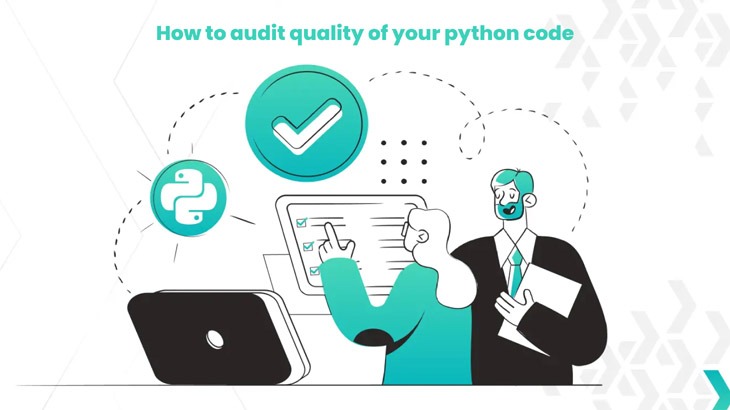Building a software development project is a bit like a game of Jenga. It uses various software like Python coding skills and arranges all the elements to create one perfect tower. Usually, it might be tweaked and worked on with no consequences. But if it has even one vulnerable place, a wrong move might ruin all the hard work.
A code audit is vital to ensure your product is quality, secure, and ready to launch. A software program requires much more work than a pile of wooden blocks, and we don't necessarily strip it of its parts but instead add the next ones. If your project has weak points, it might doom the entire construction.
Python development skills play a crucial role in this factor, and it's essential to know well about them. It doesn't matter how well-written the rest of your code is if that one tool you used is outdated and might cause serious security breaches. And the more sensitive data your product deals with, the more careful you have to be.
What is Code Quality?
One way to define code quality is to look at one end of the spectrum: high-quality code. Hopefully, you can agree on the following high-quality code identifiers:
1. It does what it is supposed to do.
2. It does not contain defects or problems.
3. It is easy to read, maintain, and extend.
These three identifiers, while simplistic, seem to be generally agreed upon. To expand these ideas further, let's delve into why each one matters in software.
How to Audit the Quality of Python Code?
Writing high-quality python code is a dream for many, but not many achieve it. Broken python codes are a nightmare for python developers. How to Audit the Quality of Your Python Code?
1. It should be easy to read and understand.
2. It should do what it is meant to do.
3. It should be free of bugs.
4. It should be easy to maintain as well as extend.
All python developers can agree to the determiners, as mentioned earlier. Additionally, one weak link in the python code can wreak havoc on your entire project. As a result, we can't emphasize auditing the quality of python code more.
Process of Python Code Audit
Our robust approach to python development makes Quixom a leading python development company. The best practices to audit the quality of python code that we share here are based on the real-life code audit. Python code audit process goes on as listed below.
Step 1: Code Repository:
The first step is to examine the code repository. You can look for the version control system to track and offer modifications to sources such as GIT. You can revisit the code repository to check if it is well-maintained.
Follow the workflow practices of Gitflow. Check for the names of the branches and verify the same. If your project is vast, you can use the appropriate Git tags.
Step 2: Technology Stack:
In the technology stack, you can verify the frontend and backend technologies used for the python development project. The next step is to check if the components are compatible. To put this into simple terms, Django works best with Postgres.
As a result, the combination is technologically more potent than any other framework database. If you find out that the technology stack is incompatible at any step, you might end up in the pool of potential problems.
Step 3: Deployment Configuration:
Well, there is no right or wrong host; you still need to pay close attention to the software offering the hosting services such as Nginx, gunicorn, uwsgi, and more. You can research more about which hosting services offer what benefits efficiently from undertaking the code audit.
It is crucial to determine whether the application depends on files responsible for the virtualization of the python development environment.
The README file should consist of the following:
1. Installation instructions
2. Configuration instructions
3. User's manual
4. Necessary copyrights and licenses
5. Contact details of developers and distributors
6. Malfunctions, issues, and bugs that are already found
7. Change log
In addition, maintain an excel sheet with all the necessary passwords and logins to run the application in the required environment.
Step 4: Skip Manual, Adopt Digital:
If you are a python developer, you might have heard about the PEP 8 style guide and PEP 257 conventions. You don't have to check for the practices manually. You can use tools to help you get through:
1. Pylama: It is a code audit tool used for JavaScript and Python. Pylama comes in handy with Python versions 2.7, 3.4, 3.5, 3.6, and 3.7.
2. Flake8: Flake8 can be used to invoke a command line using Python, and Git can call it.
3. Pylint: Pylint helps in analyzing whether the declared interfaces have been implemented in the code. It also checks the code's length and variable names as per the code standards.
4. Bandit: It is used to identify common security issues related to the python code. To detect the security concerns, Bandit can process each of these files and build an AST and run against the AST nodes.
How to Get Rid of Lints?
Lints in the python code are inconsistent errors and illogical codes that impact your code's quality. There is no easy way to detect these lints in the python code. These can be incorrect tabbing, open brackets, mistyped variables, the wrong set of arguments, and more.
Basically, there are two types of lints:
1. Stylistic Lint: When the python code does not conform to the defined set of conventions, it is known as stylistic lint.
2. Logical Lint: When there are unpredictable code patterns, unintended results, and errors in the python code, it is known as logical lint.
To get rid of the lint and audit the quality of python code, you need to designate the task to linters. Linters can analyze the code and provide better insight into it. There are tools that you can use to prevent lints.
Data Mining
Python helps to work with various models of data structures. They can easily upload data in the format of their choice. Besides this, it is even possible to organize these data stacks to make them readable. In addition, Python provides the ability to manipulate data, which can be used to resolve any issue arising in the system at any given point in time.
Initial Stage:
You have probably read all the python development requirements carefully and formed a logic to write a code. However, being in the coding zone, you might diverge from the path. As a result, it is equally important to keep reviewing your python code while writing it. This helps in changing the code in the initial phase itself and reduces the time taken during the review and audit of the python code.
Intermediary Stage:
Once you and your python development team have completed writing the code, you can review each other's code to check for potential errors.
Such practices can help identify the bugs early in python development for the necessary actions to be taken. This also helps keep the deployment timelines on track.
Final Stage:
Once you and your team are done with the project development and the QA has submitted the report, you can opt for python code audit services to help professionals analyze the code from a fresh perspective.
At Quixom, we provide auditing services for your python code and suggest a consistent and logical code to keep the python development project up and running without any bugs or errors.
Code Audit vs Code Review
Someone from the team does code reviews, focusing on one part of the code. In stark contrast, someone outside the team or the organization performs a code audit for the whole project. To further give you a line of difference between these two, code review is about testing different codes to check if they are working.
On the other hand, a code audit is about giving a python project ng a test drive to someone. Code audit provides Python with development projects the necessary stimulus by allowing a third party to test the code. And the saying, "the more, the merrier," may not be made for python developers, but it stands relevant for the code to be bug-free.
Code audits are done to secure and meet the current quality standards of the python codes. So, in a way, you can outsource code auditing to another Python development company while your team can do code review in-house.
When Do you Need to Audit the Quality of your Python Code?
Python development has numerous stages, and you might need the python code audit on various occasions.
Before the Launch:
This one goes without saying. You need to ensure that the quality of your python code is impeccable, which calls for efficient code handling. Since your python software will be exposed to the masses, you will get reviews for the same. As a result, you need to be 100% sure about the quality of your python code.
Post Inheriting the Legacy Code:
When you have inherited the legacy code and look forward to analyzing the future scope of the project, you need to add in the auditing of the python code.
Before Making Investment in a Project:
Numerous IT companies are offering the best python development services. However, if you are new to the development terms, you must seek a python code audit to ensure that the project that you are investing in is a safe bet to place.
Suboptimal Product Quality:
It's time to get your python code the audit it requires. You can check the code and make the necessary changes to improve it.
When Should You Check the Quality of your Python Code?
While working on a python development project, you must pick up on the quality at the right time. There are no set guidelines for checking the quality of your python code. However, if you believe the experts, there are three most common instances when you can do so:
There are a few things to consider on our journey for high-quality code. First, this journey is not one of pure objectivity. There are some strong feelings about what high-quality code looks like.
While everyone can hopefully agree on the identifiers mentioned above, the way they achieve is subjective. The most opinionated topics usually arise when discussing performing readability, maintenance, and extensibility.
















Post Comments